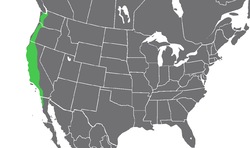赭鵝膏
科學分類 界:
真菌界 Fungi 門:
擔子菌門 Basidiomycota 綱:
傘菌綱 Agaricomycetes 目:
傘菌目 Agaricales 科:
鵝膏菌科 Amanitaceae 屬:
鵝膏菌屬 Amanita 種:
赭鵝膏 A. ocreata 二名法 Amanita ocreataPeck 
赭鵝膏的分佈
赭鵝膏(學名Amanita ocreata)是一種有毒的擔子菌門真菌。它們分佈在北美洲太平洋西北地區及加州植物區系省,菌根於橡樹。子實體於春天長出,菌蓋呈白色或赭色,中心褐色,蕈柄、菌環、菌褶及外被是全白的。
赭鵝膏的外觀像很多食用菇,因而增加了意外中毒的風險。成熟的子實體很易與A. velosa、A. lanei或粘蓋草菇混淆,未成熟的則與可食用的蘑菇屬相似。其毒性能及毒鵝膏、鱗柄白鵝膏及雙抱鵝膏,曾造成加利福尼亞州多種菌類中毒致命事件。[1]主要的毒素為蠅蕈素,會對肝臟及腎臟造成破壞,引致死亡,現時未有解毒劑。[2]初期徵狀都是在消化系統的,包括腹痛、腹瀉及嘔吐,會維持2-3日。6-16日後會出現黃疸、腹瀉、譫妄、癲癇、昏迷及最後死亡。
分類及命名
赭鵝膏最先是由美國真菌學家Charles Horton Peck於1909年描述的。[3]種小名是源自拉丁文的「穿著護脛套」[4],意指其寬鬆的外被。[5]它們與毒鵝膏同屬鵝膏菌屬,連同多種全白色的鵝膏菌屬一同被稱為「毀滅天使」或「死亡天使」:雙抱鵝膏及鱗柄白鵝膏。[5]
特徵
赭鵝膏比其他的「毀滅天使」粗壯一些。最初它們呈白色及卵狀,由外菌膜所覆蓋,及後會長出子實體。菌蓋最初呈半球體,後來會變得突出及扁平,有時甚至呈不規則形狀。菌蓋直徑可達12厘米,呈白色、黃白色至赭色不等,有時中心呈褐色。有時子實體會呈粉紅色。菌蓋以下的其餘部份都是白色的。菌褶很密。蕈柄高8-20厘米,頂部厚1.5-2厘米,有一層白色的菌環。外被很薄、光滑及呈囊狀,包裹著差不多蕈柄的一半。孢子印是白色的,孢子呈亞球形至卵形至亞橢圓形,澱粉孢子約有9–14 x 7–10微米的大小。[1]赭鵝膏一般沒有氣味,子實體有時會有一陣漂白劑或氯、死魚或碘的氣味。以氫氧化鉀倒在菌肉上會出現黃色著色。[6][7]
赭鵝膏的外觀像可食用的野蘑菇及蘑菇,在打開菌蓋及見到菌褶前像馬勃屬,所以採集時很易產生混淆。它們也像可食用及珍貴的A. velosa,且分佈在同一地區。分別只在於A. velosa沒有菌環、菌蓋邊有條痕及外菌膜較厚。[5]可食用的A. lanei也沒有菌環,而菌蓋上的菌膜較深色。粘蓋草菇的孢子呈粉紅色,沒有菌環或外被。[8]
分佈及生長地
赭鵝膏於1月至4月生長,除A. calyptroderma外,較其他鵝膏菌屬都要遲。它們生長在北美洲太平洋海岸[1],由華盛頓經加利福尼亞州至墨西哥下加利福尼亞州的林地。[7]它們也有可能分佈在英屬哥倫比亞的溫哥華島,但卻未經證實。[9]它們外生於海岸櫟[10]及榛屬。[7]在俄勒岡州及華盛頓,它們可以外生於太平洋桿櫟。[9]
毒性
赭鵝膏的毒性很高,北美洲就曾有多宗與它們有關的中毒事件。它們含有鵝膏毒素及鬼筆毒素,只要吃了菌蓋的一半就足以致命。[1][10]由於吃了赭鵝膏的人大部份都會出現器官損壞,死亡率更達40%,所以它們是鬼筆鵝膏菌組中最毒的。[11]甚至狗吃了也會致命。[12]
鵝膏毒素含有最少八種擁有相似結構的化合物,這種結構是八環的胺基酸。[13]在赭鵝膏中,α-鵝膏毒肽及β-鵝膏毒肽是最主要的毒素。[1][14][15]毒素會抑制RNA聚合酶II,對合成mRNA、微RNA及小核RNA有所影響。沒有mRNA,主要的蛋白質生物合成及細胞代謝就會停止,細胞繼而死亡。[16]首當其衝的器官就是肝臟及腎臟。[10]
鬼筆毒素包含了最少七種化合物,都有著相似的肽環。雖然鬼筆毒素對肝臟細胞是劇毒[17],但它們並沒有增加赭鵝膏的毒性,因為它們不會在消化道內被吸收。[16]再者,在可食用的赭蓋鵝膏菌中也含有其中一種鬼筆毒素的鬼筆環肽。[13]
病徵
赭鵝膏中毒的徵狀都是在消化道內的,包括腹痛、腹瀉及嘔吐,並導致脫水。嚴重的也會出現低血壓、心跳過速、低血糖及酸鹼失衡。[18][19]初期徵狀會維持2-3日,接著肝臟會出現較嚴重情況,因急性肝衰竭及肝性腦病變而導致黃疸、腹瀉、譫妄、癲癇及昏迷。[20]腎衰竭(不論是嚴重肝炎的併發症[21][22]或腎臟直接中毒的損害[16])及凝血病可能會在此階段出現。期後會出現危害生命的情況,包括顱內壓增加、顱內出血、敗血症、胰臟炎、急性腎衰竭及心搏停止。[18][19]於中毒後6-16日就會死亡。[23]
治療
赭鵝膏中毒是需要住院治療的一種急症。治療主要有四項,包括初期護理、支援措施、特別治療及肝臟移植。[2]
初期護理包括以活性炭或洗胃來將胃部消毒。不過由於在吃下及中毒之間存在一些時間差,病人很多時是在吃下後很久才入院,減低了初期護理的作用。[2][24]支援措施是處理病人脫水,控制代謝性酸中毒、低血糖、電解值不平衡及凝血障礙。[2]
鵝膏毒素中毒並沒有解毒劑,但也有一些特別的治療方法,如注射青霉素G就可以增加生存率。[25]注射水飛薊素亦可以減低鵝膏毒素的效力,阻止肝細胞的吸收。[26][27]在出現肝衰竭的病人就需要進行肝臟移植來保存生命。[28]不過,證據顯示中度至嚴重中毒的病人中,只有一半能生存下來。[10]只要在吃下赭鵝膏後的36小時內獲得治療,大部份病人都可以完全康復而沒有後遺症。[29]
參考
-
^ 1.0 1.1 1.2 1.3 1.4 Ammirati, Joseph F.; Harry D. Thiers, Paul A. Horgen. Amatoxin containing mushrooms:Amanita ocreata and Amanita phalloides in California. Mycologia. 1977, 69 (6): 1095–108. doi:10.2307/3758932. 引文使用过时参数coauthors (帮助)
-
^ 2.0 2.1 2.2 2.3 Enjalbert F, Rapior S, Nouguier-Soulé J, Guillon S, Amouroux N, Cabot C. Treatment of amatoxin poisoning: 20-year retrospective analysis. Journal of Toxicology - Clinical Toxicology. 2002, 40 (6): 715–57. PMID 12475187.
-
^ Peck, Charles Horton. New species of fungi. Bull. Torrey Bot. Club. 1909, 36: 329–39. doi:10.2307/2479371.
-
^ Simpson, D.P. Cassell's Latin Dictionary 5. London: Cassell Ltd. 1979: 883. ISBN 0-304-52257-0.
-
^ 5.0 5.1 5.2 Arora, David. Mushrooms demystified: a comprehensive guide to the fleshy fungi 2nd. Berkeley: Ten Speed Press. 1986: 271–3. ISBN 0-89815-169-4.
-
^ Thiers HD. The Agaricales (Gilled Fungi) of California 1: Amanitaceae. Eureka, CA: Mad River Press. 1982. ISBN 0-916422-24-0.
-
^ 7.0 7.1 7.2 Tulloss, Rodham E. Amanita ocreata Peck "Western American Destroying Angel". Studies in the Genus Amanita Pers.(Agaricales, Fungi). 2005 [2007-11-13].
-
^ Wood, Michael; Fred Stevens. California fungi:Amanita ocreata. The Fungi of California. 1998–2007 [2007-11-13]. 引文使用过时参数coauthors (帮助)
-
^ 9.0 9.1 Birch, Shannon. Is Amanita ocreata on Vancouver Island? (PDF). Fungifama. April 2006: 5 [2007-12-11].
-
^ 10.0 10.1 10.2 10.3 Benjamin. Mushrooms: poisons and panaceas: A Handbook for Naturalists, Mycologists, and Physicians. W.H. Freeman & Company. 1995. ISBN 978-0716726494.
-
^ Beug, Michael. Reflections on Mushroom Poisoning – Part I (PDF). Fungifama. April 2006: 3–5 [2007-12-11].
-
^ Tegzes, John H; Birgit Puschner. Amanita mushroom poisoning: efficacy of aggressive treatment of two dogs. Veterinary and Human Toxicology. 2002, 44 (2): 96–99. PMID 11931514. 引文使用过时参数coauthors (帮助)
-
^ 13.0 13.1 Litten, Walter. The most poisonous mushrooms. Scientific American. March 1975, 232 (3): 90–101. PMID 1114308.
-
^ Köppel, C. Clinical symptomatology and management of mushroom poisoning. Toxicon. 1993, 31 (12): 1513–40. PMID 8146866. doi:10.1016/0041-0101(93)90337-I.
-
^ Dart, Richard C. Mushrooms. Medical toxicology. Philadelphia: Williams & Wilkins. 2004: 1719–35. ISBN 0-7817-2845-2.
-
^ 16.0 16.1 16.2 Karlson-Stiber, Christine; Hans Persson. Cytotoxic fungi - an overview. Toxicon. 2003, 42 (4): 339–49. PMID 14505933. doi:10.1016/S0041-0101(03)00238-1. 引文使用过时参数coauthors (帮助)
-
^ Wieland; V.M. Govindan. Phallotoxins bind to actins. FEBS Letters. 1974, 46 (1): 351–3. PMID 4429639. doi:10.1016/0014-5793(74)80404-7. 引文使用过时参数coauthors (帮助)
-
^ 18.0 18.1 Pinson, C. Wright; 等. Liver transplantation for severe Amanita phalloides mushroom poisoning. American Journal of Surgery. May 1990, 159 (5): 493–9. PMID 2334013. doi:10.1016/S0002-9610(05)81254-1. 引文格式1维护:显式使用等标签 (link)
-
^ 19.0 19.1 Klein AS, Hart J, Brems JJ, Goldstein L, Lewin K, Busuttil RW. Amanita poisoning: treatment and the role of liver transplantation. American Journal of Medicine. February 1989, 86 (2): 187–93. PMID 2643869. doi:10.1016/0002-9343(89)90267-2.
-
^ North, Pamela Mildred. Poisonous plants and fungi in colour. London: Blandford Press. 1967. OCLC 955264.
-
^ Nicholls DW, Hyne BE, Buchanan P. Death cap mushroom poisoning. The New Zealand Medical Journal. 1995, 108 (1001): 234. PMID 7603660.
-
^ Vetter, János. Toxins of Amanita phalloides. Toxicon. January 1998, 36 (1): 13–24. PMID 9604278. doi:10.1016/S0041-0101(97)00074-3.
-
^ Fineschi, V; M. Di Paolo & F. Centini. Histological criteria for diagnosis of Amanita phalloides poisoning. Journal of Forensic Science. 1996, 41 (3): 429–32. PMID 8656182. 引文使用过时参数coauthors (帮助)
-
^ Vesconi S, Langer M, Iapichino G, Costantino D, Busi C, Fiume L. Therapy of cytotoxic mushroom intoxication. Critical care medicine. 1985, 13 (5): 402–6. PMID 3987318. doi:10.1097/00003246-198505000-00007.
-
^ (德文)Floerscheim, G.L.; O. Weber, P. Tschumi & M. Ulbrich. Clinical death-cap (Amanita phalloides) poisoning: prognostic factors and therapeutic measures. Schweizerische medizinische Wochenschrift. August 1982, 112 (34): 1164–1177. PMID 6291147. 引文使用过时参数coauthors (帮助)
-
^ Hruby K, Csomos G, Fuhrmann M, Thaler H. Chemotherapy of Amanita phalloides poisoning with intravenous silibinin. Human toxicology. 1983, 2 (2): 183–95. PMID 6862461. doi:10.1177/096032718300200203.
-
^ (意大利文)Carducci, R.; 等. Silibinin and acute poisoning with Amanita phalloides. Minerva Anestesiologica. May 1996, 62 (5): 187–93. PMID 8937042. 引文格式1维护:显式使用等标签 (link)
-
^ Ganzert M, Felgenhauer N, Zilker T. Indication of liver transplantation following amatoxin intoxication. Journal of Hepatology. 2005, 42 (2): 202–9. PMID 15664245. doi:10.1016/j.jhep.2004.10.023.
-
^ Giannini L, Vannacci A, Missanelli A, Mastroianni R, Mannaioni PF, Moroni F, Masini E. Amatoxin poisoning: A 15-year retrospective analysis and follow-up evaluation of 105 patients. Clinical toxicology (Philadelphia, Pa.). 2007, 45 (5): 539–42. PMID 17503263. doi:10.1080/15563650701365834.
外部連結



